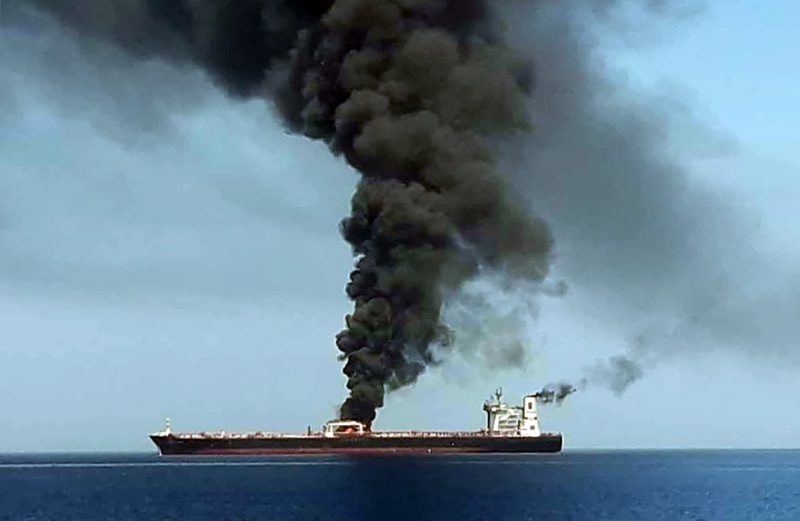Two tankers catch fire after suspected Gulf of Oman attacks
A picture obtained by AFP from Iranian State TV IRIB on June 13, 2019 reportedly shows smoke billowing from a tanker said to have been attacked off the coast of Oman (HO)
Dubai (AFP) – Suspected attacks left two tankers in flames in the waters of the Gulf of Oman Thursday, sending world oil prices soaring as Iran helped rescue stricken crew members.
The mystery incident, the second involving shipping in the strategic sea lane in only a few weeks, came amid spiralling tensions between Tehran and Washington, which has pointed the finger at Iran over earlier tanker attacks in May.
The Norwegian Maritime Authority said three explosions were Thursday reported on board the Norwegian-owned tanker Front Altair after it was “attacked” along with the Singapore-owned ship Kokuka Courageous.
Iran said its navy had rescued 44 crew members after the two vessels, which were carrying highly inflammable material, caught fire.
TV images showed huge, thick plumes of smoke and fire billowing from one of the tankers as it lay out to sea.
Iranian Foreign Minister Mohammad Javad Zarif spoke of “reported attacks” as Japan’s prime minister held talks in Tehran.
“Suspicious doesn’t begin to describe what likely transpired this morning,” Zarif tweeted.
The US Fifth Fleet said its warships had received distress calls from both vessels in a “reported attack”.
Iranian state media said the first incident occurred on board the Front Altair at 8:50 am (0420 GMT) 25 nautical miles off Bandar-e-Jask in southern Iran.
The Marshall Islands-flagged tanker, a 111,000-tonne vessel, was carrying a cargo of ethanol from Qatar to Taiwan, official news agency IRNA reported.
“As the ship caught fire, 23 of the crew jumped into the water and were saved by a passing ship and handed over to the Iranian rescue unit,” it said.
“An hour after the first accident the second ship caught fire at 9:50 am 28 nautical miles off the port.”
“I can confirm that the vessel has NOT sunk,” Robert Hvide Macleo, chief executive for the ship’s owner Frontline, wrote in a text message to AFP. No injuries were reported.
The Panama-flagged Kokuka Courageous was headed to Singapore from Saudi Arabia with a cargo of methanol, and 21 of its crew jumped and were rescued, IRNA said.
– ‘Security incident’ –
Singapore-based BSM Ship Management said it had “launched a full-scale emergency response following a security incident” involving the Kokuka Courageous which is owned by Japanese company Kokuka Sangyo Ltd.
“The 21 crew of the vessel abandoned ship after the incident on board which resulted in damage to the ship’s hull starboard side,” it said.
“One crew man from the Kokuka Courageous was slightly injured in the incident and is receiving first aid.”
It said the vessel was about 70 nautical miles from the United Arab Emirates and just 14 from the coast of Iran.
Japan’s Economy, Trade and Industry Minister Hiroshige Seko told reporters in Tokyo: “A tanker carrying Japan-related goods was attacked.
“There were no injuries among the crew members. They got off the tanker. There were no Japanese members.”
The incident came as Japanese Prime Minister Shinzo Abe was on an unprecedented visit to Iran, seeking to defuse tensions between Toyko’s ally Washington and the Islamic Republic.
Tehran said it has dispatched a helicopter from the port of Bandar-e-Jask to the ships’ location for “further investigation”.
The US Fifth Fleet said: “We are aware of the reported attack on tankers in the Gulf of Oman.
“US naval forces in the region received two separate distress calls at 6:12 am. local time and a second one at 7:00 am.”
– Oil price spike –
World oil prices spiked after a merchant shipping information service run by Britain’s Royal Navy reported an “incident” in the Gulf of Oman.
“Tension across the Middle East is high — and the attacks on two tankers has further exacerbated the situation, even though there does not appear to have been any damage to the cargos,” said John Hall, chairman of British-based consultancy Alfa Energy.
Global oil prices gained around four percent immediately after the reports of the attack. Benchmark Brent oil was trading at $61.74 a barrel, up about three percent.
The European Union called for “maximum restraint” to avoid an escalation in the region.
The Gulf of Oman lies at the other end of the strategic Strait of Hormuz from the Gulf, part of a vital shipping lane through which at least 15 million barrels of crude oil and hundreds of millions of dollars of non-oil imports pass.
On May 12, four oil tankers — two Saudi, one Norwegian and one Emirati — were damaged in still unexplained attacks in the Gulf of Oman off the United Arab Emirates.
US National Security Advisor John Bolton said Iranian naval mines were almost certainly behind those attacks but declined to provide specific evidence that Tehran was involved.
The UAE said last week that initial findings of a five-nation investigation delivered to the United Nations pointed to the likelihood that a state was behind the bombings, but added there was no evidence yet that Iran was involved.
The initial findings showed that it was “highly likely” that four Limpet mines, which are magnetically attached to a ship’s hull, were used in the attacks, placed by trained divers who were deployed from fast boats.
Saudi King Salman earlier this month warned a meeting of the Organisation of Islamic Cooperation that “terrorist” attacks in the Gulf region could imperil global oil supplies, as he sought to galvanise support among Islamic countries against arch-rival Iran.
The world’s top oil exporter has ratcheted up tensions with Iran after the sabotage attacks, which were followed by an attack on a key Saudi oil pipeline, which was claimed by Yemen’s Huthi rebels.
Disclaimer: Validity of the above story is for 7 Days from original date of publishing. Source: AFP.


